
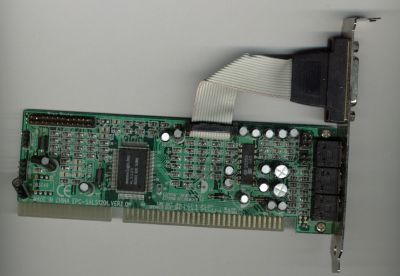
|
Avance ALS120 - 1995 A budget level ISA sound card from many years ago. Pretty much average, it is what a sound card had to be back then, a DAC (for output), an ADC (for recording) in full-duplex (able to do both at the same time) which is software based unless the Wavetable card is attached. The DIP package is a UTC TEA2025 series dual 5W audio amplifier (which can be reused as a portable amplifier!). It has a 50Ω input impedance and is rated for highest power when driving a 4Ω load impedance. These things were usually designed in a way to allow the circuit designer to treat them as a pair of LM386s. Sound cards were expected to be able to drive small passive speakers, and this one had jumpers to configure the speaker out between a powered speaker out and a line-level output, for speakers with their own amplifier. The ALS120 IC does have an IDE interface on board, but it is unimplemented on this card, seen by the number of floating pins on the SM-PLCC package. Sound cards of the day offered the ability to connect a CD-ROM drive, as onboard ATA ports often didn't support ASPI for removable drives in the ISA days, this was the very last vestiges of that capability. It also can be seen that an electrolytic capacitor has broken from the card in position C31. This is associated with the amplifier, and this card wasn't used with the amplifier active. This card is about on par with the Soundblaster16. Back then all the sound card was was a codec (encoder/decoder) to convert digital PCM data to analog audio and back again. Some handled crude MIDI synthesis but most were just employed as nothing more than what our onboard AC'97s do. The header at the top is for a WaveTable card, often branced as "WaveBlaster", which was a small DSP and EEPROM containing samples. It extended synthesiser capability. Avance offered its own PRO32AW model, which had an AdMOS QDSP QS1000 and half a megabyte of ROM. 512 kB to 1 MB and 32 voice polyphony was about standard for the era. CPUs, of course, had no such limitation and could usually handle 100-400 voice polyphony by the time we reached 200 MHz or so. Interfacing through the 26 pin connector was achieved via a standardised interface, modeled after Creative's WaveTable, which only used 12 of the connectors: +5V, +12V, -12V, TTL-MIDI in/out, Audio R in/out, Audio L in/out, !Reset, digital ground and analog ground. Each audio channel had its own ground, and each digital signal had its own ground. Digital grounds were also used for the voltage rails, though in implementation, all audio and all digital grounds were typically tied together. The sound card itself presented a MPU-401 interface into the MIDI device to the host PC. Avance Logic has since been aquired by Realtek Semiconductor and now operate as a subsidiary, designing and producing Realtek's ALC series of phenomenally popular AC'97 and Azalia codecs, such as the ALC650 and ALC850. |
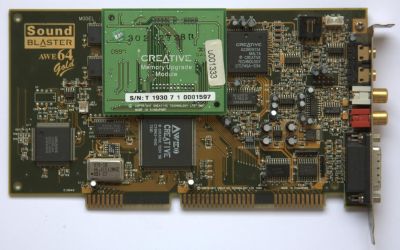
|
Creative Soundblaster AWE64 Gold - 1996 While the 'AWE' thing was mostly a joke, submitter David Young comments that "It was the first sound card I had that wasn't obviously 'the computer' when connected to my stereo" and he has a point. As mentioned in the AWE64 above, the output quality of Creative's AWE 32 and 64 was excellent, for the time. Like the AWE32, both AWE 64 models use clumsy MIDI synthesis and the wavetable (card attached in this example) doesn't really help things, the AWE DSP uses an awful bank filter for pitch shifting. It's important to understand that back then, MIDI was a very important feature. Games used MIDI for their music almost exclusively and so a better MIDI output was one of the main reasons to select a sound card. The sample bank (basic instrument sounds, which were then pitch-shifted by the hardware) on Creative sound cards was usually fairly basic until the Wavetable was added, a much extended bank of sounds. See the AWE 32, above, for the single chip used to store samples on that card, the AWE 64 is not much different. Adding the Wavetable made MIDI output much better. Later, Creative would take the sample bank into system RAM (as a SoundFont) as the PCI bus was more than fast enough to stream numerous audio channels over but it wouldn't be until the Audigy2 that Creative would make a decent PCI sound card and by then, MIDI was all but irrelevant, CPUs had become easily powerful enough to decode MP3 audio with negligible impact, something a 486DX66 needed almost all its available execution power to do. The major ICs are, left to right, CT8908 and DSP, a RAM chip (more of these under the green daughterboard), the CT8903 AWE64 bus interface and wavetable processor, the CT1745A DAC, the CT1703A ADC and, at the bottom right, two bus transcievers. Among the miscellaneous minor ICs are a pair of TL074C J-FET quad op-amps which likely handle line-level signals. This particular card is the "Gold" variant which means it has coaxial S/PDIF outputs where the system's wave output bypasses most of the card's processing completely and is only mixed with any MIDI being output; The card becomes just a mixer. The CT8903-DAO's name denotes this feature, the DAO means "Digital Audio Output". This was back when Creative was serious about PC audio, before it transitioned into a marketing company in around 1999. You could indeed put better sound cards into an ISA slot than an AWE64 Gold, but they were huge things with breakout boxes from Terratec and M-Audio, intended for studio use. ADC/DAC duties are handled by Creative's own CT1745A-S, the square PLCC package just right of the memory upgrade module. Thanks to David Young for providing the part |
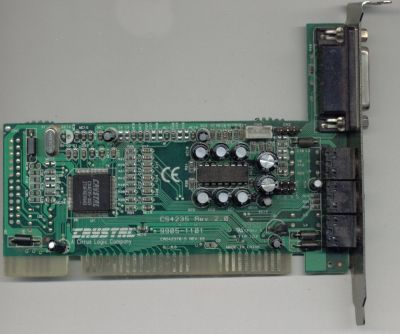
|
Crystal CX4235- 1997 Of the critically acclaimed ISA CX423x series, which included the Turtle Beach Tahiti, these sound cards have aged with grace. For the same price as the Avance ALS120, much better performance and high quality sound made these the sound cards of choice when they were new, blowing the SB16 clean out of the water (the 86dB of the 16bit, 44.1kHz codec may not be great by today's standards, but it was awesome back then). Several Pentium era motherboards shipped with CX4232B or CX4237B chips on board to provide fine integrated audio. The card does have the positions soldered for a Wave Blaster wavetable card, but the header isn't affixed. The layout of the card is a trademark of Crystal, it's neat and efficient high quality component placements contrast starkly with the cheap ALS-120. The CX4235 is the successor to Crystal's CX423xB series and was released in 1997, indeed the PCB of this card is denoted "CAD4237B", telling us it was originally designed for the CX4237B. All Crystal's sound devices had intregrated ADC/DAC and capable of using both simultaneously, something which was desurable at the time, known as "full duplex". Like the ALS120 also on this page, the DIP package is a 2025 series op-amp, this one being fabbed by ST. Datasheet |

|
Creative Soundblaster AWE64 - 1997 This'll bring back memories for some people. The Soundblaster AWE64 was the last decent sound card that Creative Labs made until the Audigy 2 (and even the Audigy 2 has its share of issues) almost eight years later. The RAM chip on the top left (between the wavetable connectors) is a 4Mbit (512kb) 60ns EDO chip and designed to store the MIDI samples. The chip next to it is an EMU 8011-01 soundfont (mostly a ROM) while beneath it is the main DSP, though you can hardly call it a DSP, the CT8920 which formed the backbone of the AWE64. The other chips are an LS245 octal bus transciever (20 pin DIP near the edge connector), GM71C4256BJ60 (far left, datasheet) 128kb (256k words, 4 bits per word) general purpose fast page DRAM and a Philips TDA1517P (datasheet), a dual 6W amplifier since back then (as the other ISA cards show) the sound card was expected to be able to directly drive speakers. In all, it was a quality built sound card (utterly obsolete) but with flawed implementation, especially in its OPL-3 output which uses a very clumsy second order sine wave generation, giving very bad harmonics. The chipset here is completely different to the the AWE 64 Gold we also have. For one, there's no discrete ADC/DAC! |
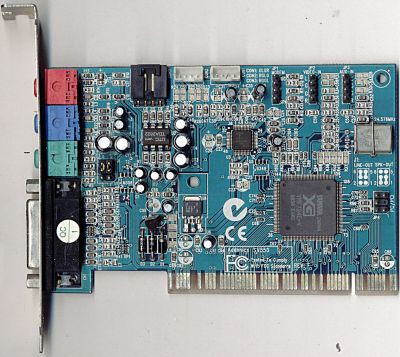
|
Addonics SV550 - 1998 The Yamaha YMF724E-V as used in the Addonics SV550 wasn't so much a sound card as a MIDI music card, featuring Yamaha's XG MIDI extensions, well regarded among MIDI enthusiasts. The YMF7xx series (datasheet for the YMF724F, a slightly later version) were among the first to lock their sample rates at 48,000Hz. All consumer sound cards usually resample to a flat rate, but it's usually 44.1kHz (meaning most CD quality audio will need no resampling at all) but the YMF7xx locked itselt to 48kHz. Various flame wars have been fought over the wisdom of this move. As the Addonics SV550 (which was the most common PCI implementation), it features a Sigmatel STAC9704T codec (datasheet) performing DAC/ADC functions which is AC'97 compliant and features an impressive 95dB SNR. The output of the card betrays its heritage, the TDA2822 (datasheet) dual power amplifier is clearly seen nestled among smoothing capacitors, capable of two watts (RMS) per channel into a 4 ohm load; Easily enough to run the unpowered desktop speakers of the day. The TDA2822 is really simple in its implementation: It is two non-inverting op-amps implementing a class AB amplifier. Of course the standard jumper pair is present to override the amplifier. A common trick back in the day was to flip only one jumper, leaving the user to puzzle why one of his speakers is so very much louder than the other! Of course, each jumper would change the output of one of the stereo channels... These dual power amplifiers are also quite ideal for portable headphone amplifiers and will run from a small 7.2V or 8.4V PP3 NiMH for quite a while. Most desktop stereo speaker pairs would use a TDA2822 and the jankiest power supply possible, they'll run from 3 to 15 volts. The TDA2822M shrinks the 12 pin DIP to an 8 pin DIP. The 12 pin package is actually implemented as a 16 pin package with four grounds, these grounds are meant for use in heatsinking (pins 4, 5, 12 and 13) The card itself was nothing special. Dell included it as a card and as an onboard device in several of their Dimension machines starting with the V series in 1998 because it was one of the first stable and reliable PCI audio cards and these were cheaper than their bulky ISA cousins. Windows 2000 and XP will pick this up automatically. WindowsME also will, but can have problems with DVD playback, in which case the VxD drivers are needed instead of the WDM drivers. Just for fun, compare the fullsize image of this card with Wikipedia's attempt of an earlier revision of the same card. |
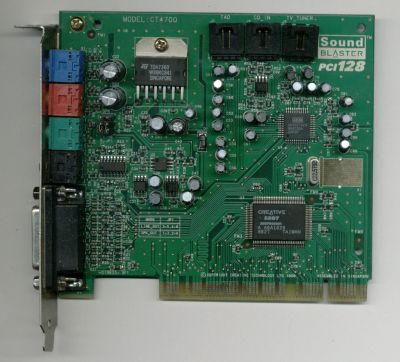
|
Creative Soundblaster PCI128 CT4700 - 1998 A rework of the Ensoniq AudioPCI. The PCI series of Soundblasters uses the Ensoniq chipsets, Ensoniq having been aquired by Creative. The CT4700 was dropped out of support after just a few years in favour of the inferior CT4750 model by 2001. The drivers in Windows2000 and WindowsXP were codec drivers, hardly any hardware features are enabled, not even hardware MIDI. The card, in hardware, does support quadrophonic sound (it has both black and green outputs as we can see), but the drivers available do not enable this feature. This is around the time when people started to really dislike Creative. This card itself is a version of the original Ensoniq AudioPCI and on the same PCB, but modified to give four jacks on the back instead of three, so enabling DirectSound 3D... Which Creative saw as a threat to EAX and did not actually allow! The components on this card are the "Creative 5507" (really an Ensoniq ES1370 chip) DSP, the Asahi Kasei Microsystems AK4531AVQ codec, a low-cost 16 bit codec designed for embedded devices which handles the audio I/O and a big ST TDA7360 22 watt stereo power amplifier for driving small to medium speakers. Without a competent heatsink, as seen here, it won't be doing 22 watts. ST describes the TDA7360 as "designed for car audio applications". As far as output amplifiers go, it's a darn good one. Two beefy capacitors near it give it the thump it needs: Check other cards around which have power amplifiers, they all have these, the output actually runs through the capacitor. To run it in bridge mode, tie Out1 and Out2 to the same speaker's + and -, and then tie Out1 (pin 10) to Out Bridge (pin 4). Bridge mode merges the two audio channels and halves the output impedance, allowing the IC to power much more powerful speakers, like subwoofers. To do this on the TDA7360 requires proper heatsinking, and it's worth remembering that the tab is connected to pin 5 (IN 2). Each channel was rated for 8 watts into 3.2 ohms, or 6.5 watts into 4 ohms and 22 watts into 3.2 ohms in bridge mode. Gain was fixed at 20 dB, so it was difficult to over-drive. The Ensoniq ES1370 was the earliest version of AudioPCI, not AC'97 compliant, so used a non-AC'97 codec (the AK4531AVQ). The later ES1371 and ES1373 were AC'97 compliant. Ensoniq AudioPCI was Ensoniq's push to PCI. It supported four channel output, and basic reverb and chorus processing. Wikipedia says that it could do DirectSound 3D, which, technically, it could, but as what DirectSound would refer to as an "emulated" device. The 3D processing happened on the CPU. As a synthesiser company, Ensoniq was late to PC audio. It didn't care: Why would it? PC sound was not Ensoniq's market. However, Ensoniq had actually entered the PC market much earlier. The Ensoniq ES5506 OTTO synthesiser chip was relabeled "Gravis GF1" and was the core of the famous Gravis Ultrasound! |
|
Audio of the Late 1990s, Early 2000s: Ensoniq AudioPCI ES1370, ES1371, ES1373 |
The Ensoniq ES1370 was released in 1997 and its development had almost bankrupted Ensoniq. Its synthesisers were selling poorly and, while its PC audio solutions were popular with OEMs, nobody ever got rich from selling $10 sound chips to Compaq. ES1370 was meant to be a long-term solution, supporting newer technologies (quadrophonic and 3D sound), at a very low cost. This would enable Ensoniq's existing OEM customers to buy Ensoniq with confidence that the product would still be relevant some years later. AudioPCI, the produced ES1370 found itself in, was one of the first products to handle Microsoft DirectSound 3D, when used with the four-channel AK4531 DAC/ADC codec. The ES1370's DSP could do spatialisation itself and needed DirectSound 3D for localisation: Tell the ES1370 where the sound is, the ES1370 will put it there. The DSP does multi-algorithm reverb and chorus, can handle 32 simultaneous MIDI voices in 16 channels, doesn't need any ISA signals generated on the card at all and could handle 16 bit, 44.1 kHz output. Other bit depths were resampled to 44.1 kHz for output. Then Creative Labs came. Ensoniq had no money but had a product. Creative had money but no product. The obvious marriage of convenience happened, resulting in ES1371 (later models as Creative CT5880) and ES1373. Creative had also bought E-mu around the same time, so quickly merged Ensoniq with E-mu. E-mu had nothing to ship just yet, and the EMU10K was still a few years away. (And was, in fact, never completed, the PCI bus interface was unfinished, among other things) They were AC'97 compliant so could use common and very cheap AC'97 codecs. The 1370 did continue in production, usually as Creative CT5507 but was otherwise quickly removed from the lineup. As AC'97, they had to output 48 KHz, which they did by resampling everything else to 48 kHz. Most sound cards had a fixed output frequency in those days. Some could alter it, but only very few could output more than one frequency at any one time, as it would require multiple quartz oscillators. Most cards you'll see have just one oscillator. A ES1373 here uses a 24.576 MHz crystal, overwhelmingly popular in A/V due to its ease of dividing into all needed clocks: Divide it by 512 and you get 48 kHz dead. It's the IEEE-1394 bus reference and the base clock for CCIR-601 video systems. It is also used as 3x 8.192 MHz and 0.5x 49.152, but probably not here. The later Creative EV1938 is a cost-reduced version which embeds the AC'97 codec (and not a good one) into an ES1371. It will work with drivers expecting the ES1371, but the OS may need coercion as the hardware IDs will not match. Software compatibility for ES137x was extremely high. They'll run in FreeBSD, Linux, Solaris, DOS, Windows 3.x, Windows 95/98/ME, WinNT x86 (NT4/2000/Vista/7), WinNT Alpha, BeOS and systems which have compatibility with those, such as Windows 8, 8.1 and 10, 32 bit only. Thee's a driver here (signed by Microsoft) for Windows 9x/NT/2k/XP/Vista and higher, but 32 bit only. Anything which will load a Windows WDM driver, such as ReactOS, will also work. The driver here is the latest available, has a version of 6.0.0000.0 and a date in the security catalog of 05 June 2008 19:26:43. The signature date is 19 September 2008 23:46:59. The ES1371 driver has a driver version of 6.1.6499.1, the ES1370 driver has a 5.1.2501.0 version. It was built as part of the Windows Longhorn (Vista) release. This is not a VxD driver and will not give any functionality to DOS games under Windows 9x. Let me make this very, very clear: There is no 64 bit Windows driver for any Ensoniq AudioPCI series device. Anyone claiming otherwise is likely trying to install unwanted software or worse. Windows XP 64-bit Edition was around at the time, but Creative didn't support it, the minimum product Creative supported on 64 bit OS was the EMU10K on the Sound Blaster Live! series. |
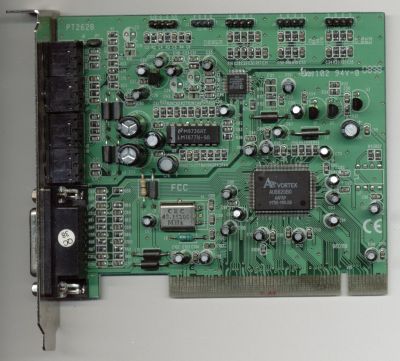
|
Aureal Vortex 8820 - 1998 A low-end variant of the Vortex series, this is a "gaming" sound card from a good few years ago. Unfortunately, it didn't like me at all and blue screened Windows2000 on two seperate machines whenever I tried to install its drivers. Windows2000's stock drivers didn't work either. WindowsXP had no problems whatsoever even though it used the same driver files! When I did get it working in Win2k, any attempt at A3D would result in a blue screen. This particular card bears a sticker on the back informing us it is V1.1 and another saying it was manufactured in March 1998. Other than the Aureal 8820 DSP, the codec employed is the Analog Devices AD1819A. A common LM1877N dual channel 2 watt op-amp power amplifier is employed to drive speakers, typically used as as the 2025 series, but not generally as good. The LM1877N had been available from National Semiconductor, Texas Instruments, and many more, since around 1995 and was intended to drive high impedances (8 ohms) with low distortion. Total harmonic distortion on LM1877N was rated to 0.045% at 500 mW/channel. |
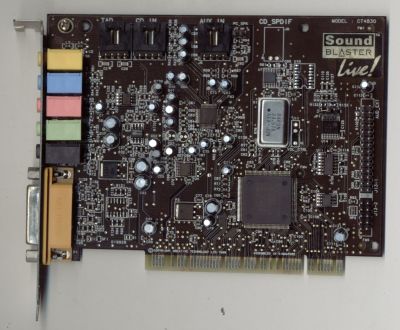
|
Sound Blaster Live! OEM CT4830 - 1999 Oh boy. Where to begin? This card was released with patchy to no driver support; You could plug it in and it would simply not be installed by the supplied "Liveware" CD - if you got a CD at all, the OEM cards were usually devoid of any documentation or driver. No problem, you'd just go online, grab the driver, install it, job's good. It had no official name, so you couldn't even search Creative's website for it. This one carries a retailer's sticker on the back saying "creative 1024 live oem" in hideous Comic Sans MS. Initially the CT4830 was the OEM version of the card, but then it entered retail as the Value OEM variant then again as the 1024 OEM variant and as the Value Digital OEM even though the digital output was completely proprietary. It was often a lottery working out exactly what card you had since the name alone would't do it and Creative seldom refered to its part numbers (CT4830 in this case). The SoundBlaster Live! was not designed by anyone who knew anything about audio electrical engineering (The EMU10K was, it weas made by E-mu, after E-mu was bought by Creative) as it made two extremely fundamental and really basic errors. The EMU10K would output digital audio to the card's onboard AC'97 to convert that to analog audio to run speakers or headphones or whatever. AC'97 allows up to 9 channels of audio, but not Creative's AC'97 in the SoundBlaster Live! as it seemingly only had two channels left for audio output. Just below it, and straddling the boundary between analog and digital domains, is a Philips UDA1334 DAC (actually a really good DAC) to handle the two rear channels. Straight away we then have a different audio pathway for front and rear. That was the first mistake, and the less serious one. After the UDA1334, we need to amplify the signal to line level for output, which is done by the dual channel op-amp in position U3 (in line with the green output), which sharp eyes will notice is not the same as the op-amp in position U2, which handles the front pair of channels. This is the cardinal sin. Front and rear were going through two very different amplifiers which had different frequency response. Okay, we're not sunk yet, we can just pre-emphasise in the EMU10K (which can do this) to neutralise the frequency response. Op-amps for audio use have their frequency response well documented, after all. Creative did not do this. Shoddy DAC/op-amp coupling is the hallmark of a low quality audio device, but it's as yet not killing us. The rear channels went through an inverting amplifier, the front channels went through a non-inverting amplifier. This was the key screw up. It meant the rear speakers were always out of phase! Coupled with the uncorrected frequency response, the rear channels had little bass, were much weaker than the front, and caused phase problems: That was the killer. The horribly implemented rear channel rendered it unusable for quality reproduction. The specs were fairly typical for the day, hardware mixing (128 channel), four output channels (2 front, 2 rear), and hardware sample rate conversion. The best part about the EMU10K1 is its ability to be reprogrammed, the DSP is programmable in software. The EMU10K1, however, is not all rainbows and flowers. Its sample rate is locked at 48kHz and must resample everything to 48kHz before output or processing, this causes quite a bit of distortion. Poor frequency response plagued the SB Live! throughout its production and on every model. This manifested as linear distortion which somehow was worse on digital outputs, even at the fixed 48kHz. The codec employed is Creative's own (at least branded Creative, it may well be an AKM, Sigmatel or Analog Devices). There is no power amplifier on the board, this was after the ability to directly drive speakers was no longer valued. To make matters worse, the EMU10K1 DSP had a flawed PCI interface and Creative couldn't quite manage to write a stable driver for it. In the words of a VIA chipset engineer on their official support forums: The Sound Blaster Live! Drivers were not to PCI specifications. This caused too much noise over the PCI bus. The engineers had to work out a way to filter this noise and released a patch to motherboard manufacturers which replicates a BIOS change. You read that right. VIA had to fix a problem in Creative's driver at the motherboard BIOS level by altering the behaviour of their chipsets to work around the issue. The EMU10K was done on a tighter budget than E-mu wanted, more quickly than E-mu wanted, and went out of the door with known but unfixed problems with its PCI interface. It got even better. MUCH better. As Windows2000 was nearing release, MS still had not recieved drivers from Creative which could pass WHQL and get on the Windows 2000 Hardware Compatibility List - This is fact, the SB Live! did not appear on the HCL until very late. This would have been a disaster for Creative: OEMs would not have been allowed to preinstall Windows 2000 on a system with a Soundblaster Live installed! Legend has it that Microsoft demanded Creative's specs and source code and proceeded to write the driver themselves, then billed Creative for the development. Despite that, the flawed nature of the EMU10K1's PCI interface continued to dog stability in both Windows 2000 and Windows XP, crashes identified as being "emu10k1.sys", the card was simply not PCI compliant and anything could cause it to crash. Oh and don't lose your CD. You can't download the full driver package from Creative. |
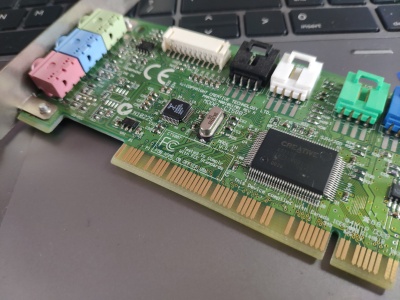
|
Creative Audio PCI 64 CT5807 (Dell 088GF, P/N 03196W) - 2000 This little thing came out of a Dell, and appears to have been custom built for Dell, for reasons we'll explore. It has just four semiconductors on the card, and we'll go left to right. Dell sometimes called it Audio PCI 64, and sometimes SoundBlaster PCI. Top left is a dual op-amp, then just above and to the left of the PCI slot is a single MOSFET being used as a VRM. Near this is the Sigmatel STAC9721T AC'97 compliant codec: The codec is the meat of the sound card, where audio is converted to data, and data converted to audio. The larger chip is an Ensoniq ES1373, which is the PCI bus interface, mixer and basic DSP. It adds S/PDIF and I²S output to the ES1371. The very right of the card has a National Semiconductor dual 3 watt audio amplifier. It is powered directly from the PCI port and doesn't even have a single electrolytic capacitor to help with peaks. Across the top of the card are five connectors, left to right: 10 pin non-standard front panel connector (custom for the Dell it came from), CD-audio (black), AUX in (white), TAD I/O (green) and powered speaker out (blue) which uses the 3 watt amplifier, a Nat Semi 03AJ dual op-amp just below it. "TAD" was rarely used, but allowed a modem to connect to the sound card and act as a voice telephone. We never once saw this in use. One thing to spot here, or to not spot, is the boundary between digital and analog domains of the card. This should run right through the codec chip, yet it's completely absent. Check some of the other sound cards to see it. This is needed for high fidelity audio reproduction, something this card appears to not be intended for. The lack of electrolytic capacitors to deliver clean signals is also quite telling. This is very clearly a made-to-order design where Dell approached Ensoniq (still not entirely subsumed into Creative Labs) with a list of requirements and a buying price. I like cards like this. They tell you a little about the era they came from (manufactured 2000-06-21!) and what they were made to do. The machine this was part of had a speaker output which wasn't on the back, it had a port cluster on the front (not common in that day) which at least had a headphone, and likely also a microphone socket on the front too... Or at least, it could have. Dell would have ordered tens of thousands of these and absorbed the unused capabilities in economics of not needing multiple parts where, say, a powered speaker output was needed. This was used across Dell's Dimension range (e.g. 4100 series) which, in that era, were always Pentium III or Celeron. As for use in the modern day, I did plug it into a Windows 10 (1809) machine, a Dell Precision T5600 dual-Xeon and it was detected as a Multimedia Audio Device but no drivers were available. There is no known 64 bit driver for this device, although there is a 32 bit driver for ES1371/ES1373. I've got it hosted here (signed by Microsoft). It's a WDM driver so should work with Windows 98, ME, 2000, XP and Vista. As a WDM Vista driver, it should also work with Windows 7, 8, 8.1 and 10 - 32 bit only. It is good for all ES1370/ES1371/ES1373 cards though cards with added features like dual-codecs (probably not on an ES137x!) won't have full functionality. |
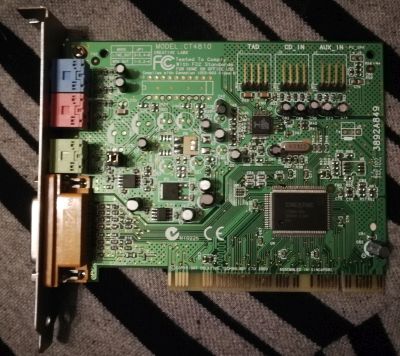
|
Creative SoundBlaster Vibra 128 CT4810 - 2000 This uses the CT5880 DSP and the Sigmatel STAC9721T AC'97 codec. It's immediately obvious that the upper left of the card is not fitted. This, as can be seen from the two jumpers nearby, is a power amplifier for running passive speakers. By 2000, speakers generally integrated their own amplifier and were "powered" or "active" speakers. Actually finding out what this was called was difficult in early 2018, the card's old enough to vote! A quick search for the model number revealed it to be the SoundBlaster Vibra 128, basically the SoundBlaster PCI 128 with a new name. The CT5880 bus interface, DSP and mixer was a relabel of the Ensoniq ES1371 and used on a number of sound cards with the names: SoundBlaster Vibra 128 SoundBlaster PCI 128 SoundBlaster PCI 128 4 Speaker Creative Ensoniq AudioPCI Sound Blaster Audio PCI 64 (Dell/Gateway OEM) And many, many more. Was it any good, then, to be used in so many products? Nope. It was downright mediocre, but very cheap. Average or typical would be used a lot. It's important to put them in context, however. These things were bargain basement speaker ports as most motherboards in the day did not have onboard audio, so, much like Nvidia's many TNT2 M64s for video and barebones "add a necessary port", a bottom feeding solution was needed. This was that solution. |
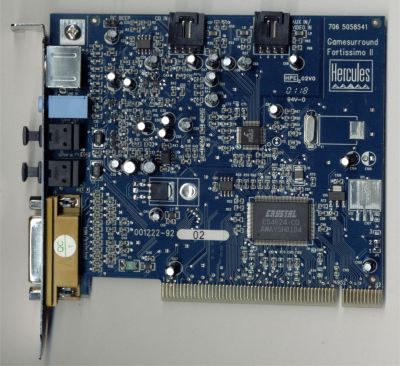
|
Hercules Gamesurround FortissimoII - 2001 A budget minded card but with many high end features and excellent sound quality. Notable not only for its low price, but also for having both optical out and optical in (TOSLink). This four channel sound card represents the little brother to the Turtle Beach Santa Cruz and the Hercules GameTheaterXP. The DSP used is the Crystal CS4624 and the codec used is the Crystal 4294 AC'97 compliant codec. On the larger image, the DSP is the large rectangular IC and the DAC is the small square 48 pin IC just above it. Most CS4624s were paired with the CS4297 codec, especially in IBM Thinkpads. The difference was in the channels supported, the 4294 was only four channel, while the 4297 could handle 7 channels (and was used in the Fortissimo III 7.1) Crystal had been bought by Cirrus Logic years ago, but were still using their own name in 2001. By 2006, however, most CS and CX components were produced under the Cirrus Logic name; Such as the CS4382 AC'97 which handles codec duties on a SoundBlaster X-Fi. The only thing it could perhaps be faulted on is the waste of an awful lot of backplane space on the silly game/MIDI port when features like coaxial S/PDIF (in and out), a centre or LFE channel, or even a powered speaker-out would have been better suited. This guy was bought to provide the TOSLink input and, with an AVerMedia TVCapture98 video capture card (and DScaler), used to hook up a PlayStation 2 to the PC, save a little desk space, and allow PS2 games to be displayed in deinterlaced upscaled glory. Today, we'd just use the PCSX2 emulator. |
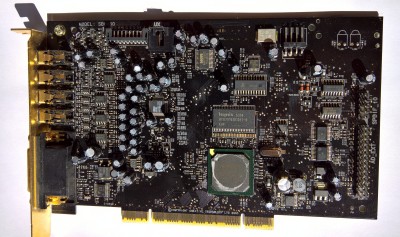
|
Creative SoundBlaster X-Fi Xtreme Music SB0460 - 2003 After the... well, tell it like it is, utter debacle of the SoundBlaster Live, Creative had almost destroyed market trust in the entire sound card market. Would the X-Fi line restore faith in the market? Bryan McIntosh thought so: I bought this to replace a Sound Blaster Live Value, and it sounded a LOT better. The X-Fi did all of the fancy EAX effects that the Audigy did; the only downside was that it did some sort of odd resampling when put in "Game Mode" or "Media Mode" that made things sound... not quite right. Since I only had a 2.1 sound system at the time (old stereo amplifier hooked up to 2 HTIB-style speakers and a sub), I didn't really care about this since in Audio Creation mode it bypassed most of the Creative ridiculousness and provided nice, clean sound output. When I upgraded to Windows Vista, I needed to download a piece of software called "Creative Alchemy" that allowed EAX effects to still work in Bioshock and Mass Effect since Vista re-wrote the audio driver stack and made EAX essentially useless. I replaced the X-Fi with a Xonar DSX in 2012, and it sounded even better; the X-Fi has been gathering dust ever since.Creative was in a bit of a bad space. Creative made and sold audio DSPs, something the market was rapidly moving away from. CPUs were getting very powerful and audio represented a very small data stream, easily processed. Each second of 16 bit, 44.1 kHz audio was just 76 kilobytes. Considering that even an Athlon XP 1700+, common in 2003, could sustain processing on up to 2.5 gigabytes per second using powerful SIMD DSP instructions, games began moving away from Creative's EAX API and using software sound processors like Miles Positional Audio and DirectX 7 HRTF. In response, Creative added weird room modes to the X-Fi, such as the Game and Media modes Bryan calls out. At this point, Creative was paying developers to include EAX, and paying publishers to force developers to include EAX! Why implement a feature which a majority the PC gaming market can't use? To Creative, the crisis was existential. If everyone moved away from EAX, there would be no Creative. The digital side of this card is handled by a Creative CA20K1 DSP, a descendant of the EMU10K in the SoundBlaster Live. It can mix 128 channels, each of which can have 8 independent effects added. All sound going into the CA20K1 is upsampled to 88.2 or 96 kHz (sample rate is doubled) before any other processing. Then mixing is done by a poly-phase finite impulse response (FIR) filter, which Creative claimed was as good as a 256-order FIR but only implemented as a 128 (or 96) order filter with an output at 192 kHz, which is divided by four to get a 48 kHz output (or 96, or just left at 192). By doing processing at a much higher sample rate, errors introduced by the low order FIR are minimised, but errors from reasmpling 44.1 kHz to 192 kHz via the FIR filter are unavoidable. The downside to all that is that absolutely everything has to be resampled to 48 kHz. Resampling to 44.1 kHz, not an even fraction of 192 kHz, would introduce more distortion than just going to 48 kHz, and the output of the FIR was locked to 192 kHz. This caused unavoidable intermodulation distortion when dealing with any 44.1 kHz source, such as almost every sound found on a PC, in a PC game or handled by a PC. If using 48 kHz samples or other audio, there was very little distortion. The analog side is handled by the Cirrus Logic CS4382 AC'97 compatible 8 channel codec, which can run up to 24 bit and 192 kHz with a quoted 114 dB dynamic range - It was used a lot in high end receivers, AV equipment and DVD players. This feeds into ST Micro 4558CN dual channel op-amps, which drive the three outputs. So, the analog side is excellent, the digital side is powerful, how do they go together? Extremely badly! Most users, Bryan included, put their cards in Audio Creation mode. What this does is bypass the entire digital side of the card and go straight to the CS4382. Creative used this chip quite a lot, in also the X-Fi Fatal1ty, X-Fi Titanium, SB Live! 24-bit and other members of the X-Fi generation. In Audio Creation mode, they were identical, even down to using the same ST 4558CN output drivers. With EAX unsupportable in Windows Vista, Creative made it a software wrapper around OpenAL, with things like Creative's own Alchemy, which essentially used the sound card as an extremely expensive dongle and did all its work on the CPU. For some reason, Creative was not very keen to make that very well known. |
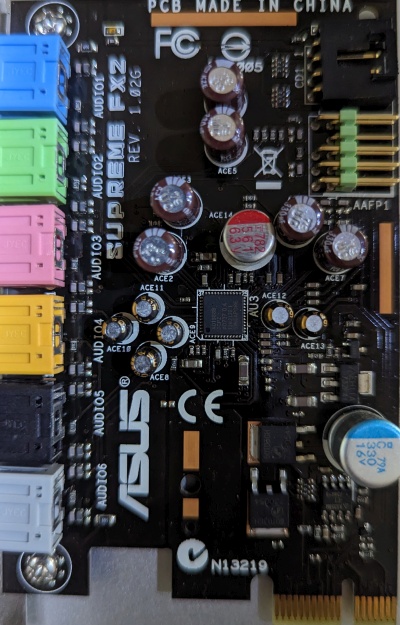
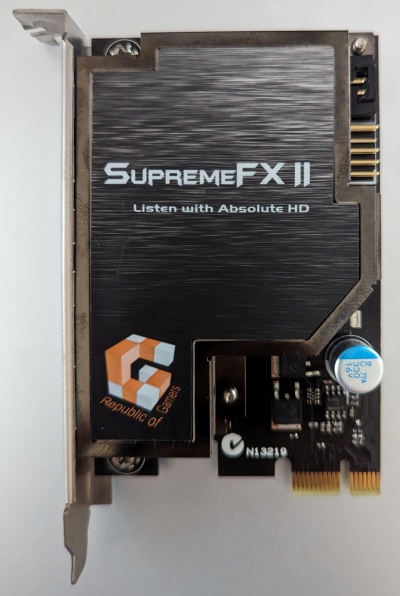
|
Asus SupremeFX II - 2008 The 2008 batch of Crosshair Formula and Maximus Formula (and P5E) motherboards came along with these guys. With the cover on, all you can see is a voltage regulator. Cover off, and we can see the components Asus has used here. Before we go into all this, it's worth remembering that high end motherboards are 50% for show and 50% for substance. There's a reason the huge capacitor on the VRM is open for inspection on this codec card! This card is 100% for show. Not occupying a PCIe slot would be a positive, but rational minds aren't the sort to buy Maximus Formula motherboards. Beginning with the codec, this is the common and low cost Analog Devices AD1988B 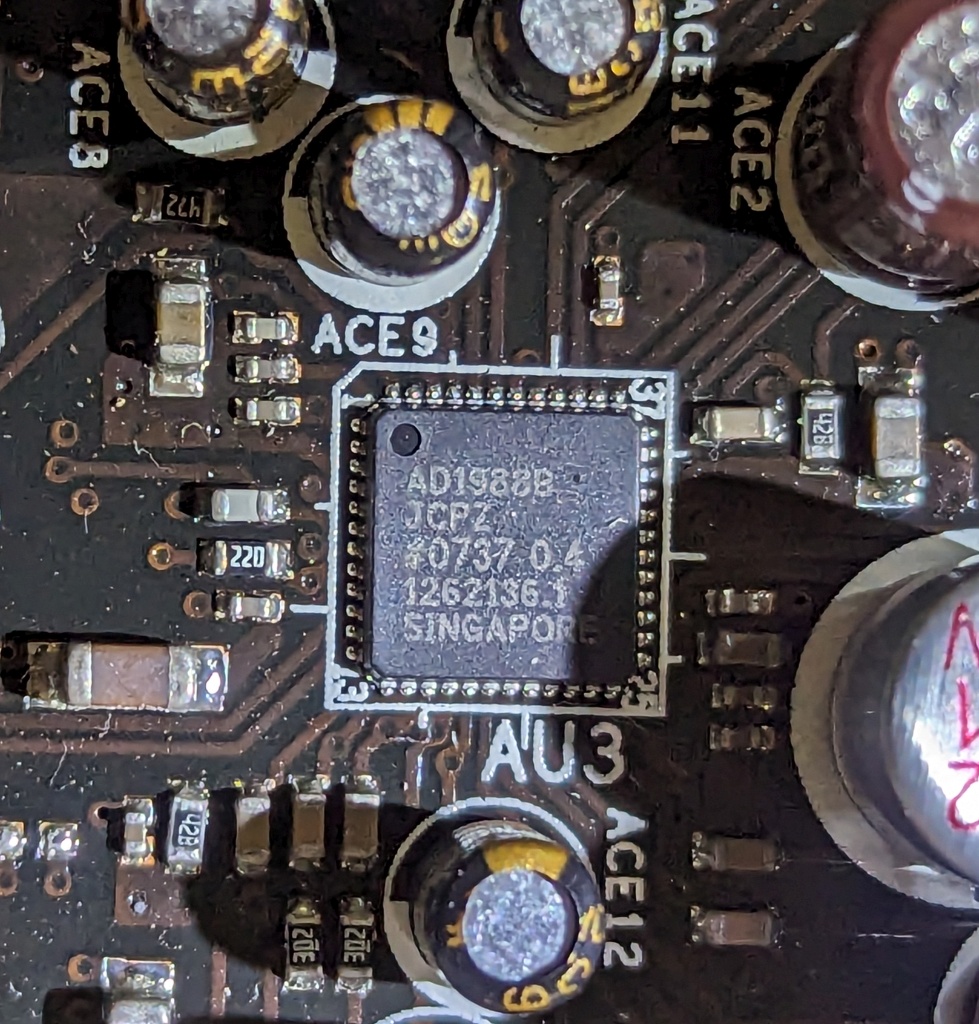 Analog Devices advertised this as having 101 dB signal to noise ratio (datasheet), up from 95 dB on the AD1988A. However, astute readers of the datasheet will be asking "Where is the PCI Express interface?". Like most HD Audio implementations, there is only serial data in and serial data out (pins 8 and 5, respectively). The digital interface is made up of these two, a reset pin, a frame sync pin, and a 24 MHz clock. Is there a PCI express to HD Audio/Azalia bus adapter here? No, gentle reader, there is not. This is not a PCI express card. It will not work in a PCI express slot. Asus provides a specially crafted slot for it, which has a specially wired connector to pass the power and the digital interface specially switched by a Pericom PI3CH3244LE (datasheet) digital bus switch. With the audio card inserted, the bus switch is activated and switches away the PCIe bus and inserts the slower HD Audio digital interface. This is why these won't work in any other motherboard, they're not actually PCIe devices, they're the audio circuitry pulled off the motherboard and placed on a riser card. Nothing else. |

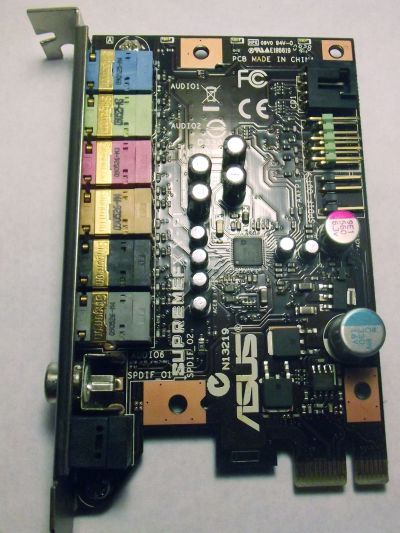
|
Asus SupremeFX X-Fi - 2007 This PCI-Express card was supplied with Asus' high-end Crosshair III Formula motherboard. Surely then, here's a "motherboard" sound solution which has some meat behind it? Guess again. It has the exact same 7.1 jacks you'd find on a motherboard, the same TOSLink out, the same S/PDIF coaxial out. And, as we're about to find out, the same codec. The codec on this card is an Analog Devices AD2000B and as the bottom image shows, there are really no other components on the card. Some electrolytic capacitors and a DC regulator, which all codecs need anyway, regardless of how they're mounted. What, dear reader, is the AD2000B? Analog Devices has no product listing for it. The detective story now comes to the operating system, where the device identifies itself as "1989" - Yes, it's an Analog Devices AD1989B. No more, no less. Like the SupremeFX II above, it is handled by a bus switch on the motherboard, which switches away the PCIe bus if this card is inserted into the compatible Asus motherboard and switches in the chipset's ordinarily not-exposed HD Audop Digital Interface. The silly thing was that the AD1989B was a very common motherboard audio codec. A whole heap of software is installed to make it "look better" in the operating system, adding EAX through to 4.0 and OpenAL, all entirely in software. The card will not work with any other motherboard, even though it has no reason not to, it won't even initialise itself - It'll just plain not show up anywhere. In essence, this is a bog standard onboard audio codec with some Creative crapware to slow down the system and a dose of marketing. As in "try not to step in the marketing". For what it is and how its mounted, it essentially removes one of the two PCI-Express x1 slots from the motherboard for no reason at all. This, then, is actually a functional negative for the motherboard and it cost more than doing it right! |
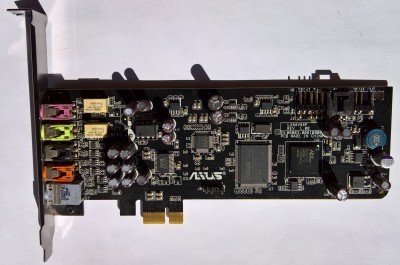
|
Asus Xonar DSX - 2012 Asus (it's pronounced Ah-soos) Xonar series was a bit of a surprise on release. Asus made motherboards, and the occasional video card. What was this sound card doing?! We need to wind back to 2008 to find out what was going on. Asus already had some Xonar cards on the market and they were highly regarded for their transparency, as well as being a "known good" where onboard audio solutions were very hit and miss. Good onboard audio was as good as anything else (or better!) but when it got bad, it got really bad. Having a Xonar meant you could shop for motherboards based on other, more important, criteria. In 2008, the market was open to disruption. Creative had severely pissed off PC audio enthuasists by going after an enthusiast who fixed Creative's severely broken Windows Vista (and, later, 7) drivers, by reinstating features Creative couldn't be bothered to do. A week later, Creative was forced into a humiliating retraction after a storm of outrage. After stating that they "forbid all so-called driver development by third parties", Creative "clarified" that it "did not make it as clear as we would have liked that we do support driver development by independent third parties". Yes, Creative. Forbidding something is not very clear that you support it. The damage had been done, and Asus' savvy marketing department saw a hole in the market and aimed a big cannon straight at Creative. A few weeks later Asus announced that EAX and EAX 2.0 would work perfectly on its Xonar sound cards, right back to the original Xonar. Before that announcement, gamers used Creative cards for games, but often Xonars for music. After it, well, what does anyone need Creative for? The Xonar DX in 2008 was no technological marvel, but it didn't need to be. It buried Creative and pissed on the grave, and there was much rejoicing. This gives us our answer to "What was this sound card doing?!" Why, dear reader, it was kicking Creative's arse. Audio was now a solved problem. By 2012 and the Xonar DSX With the Asus AV66 audio processor (All Asus audio processors were re-branded C-Media Oxygen HD DSPs) handling the digital side, and Wolfson (now Cirrus Logic) WM8776S and WM8766G audio codecs handling the analog side, Asus used the DSP for its capacity to be a Dolby DTS decoder with speaker virtualisation. It'd still do EAX up to EAX 5.0 for legacy games. Take it away, Bryan McIntosh: The Xonar DSX is still in use in my primary PC. Modern motherboard sound is good, but this card sounds just a LITTLE bit better. I bought it to replace my X-Fi back in 2012, after the Tech Report published their review and showed that it provided incredibly high quality sound for not a lot of money (Tech Report ). This card's drivers worked well (and continue to do so even under Windows 10), and it's nice to have a separate sound device for recording and playback. It's currently hooked up to a decent pair of bookshelf speakers and sounds about as good as the on-board audio or the HDMI/DisplayPort passthrough on my monitor; its one main advantage is REALLY good recording ability. I haven't tried its optical output or its Dolby Digital real-time encoding at all, since I've not had a surround sound system since buying the thing back in 2012.The PC audio market was stable and Creative nowhere to be seen. Asus' Xonar DSX, with the DGX, followed in the DX's footsteps as a budget-friendly audio solution. Very importantly for some, The DSX's headphone op-amp was replaceable. If you didn't like it, you could pull it from the DIP socket and insert your own! Fitted as standard was the Texas Instruments NE55329. TI's NE55329 was pretty much all anyone needed, it was a dual non-inverting amplifier, high slew rate (9V per microsecond!) and very low THD, specified as just 0.002% at 1 kHz. And, well, it cost almost nothing. Enthusiasts liked to swap in their own headphone amps for the placebo effect and would usually use an amp rated much worse than the NE5532 series: Audiophiles and electrical engineers have surprisingly little crossover! People would literally buy a Xonar and post questions like "Upgrade for NE5532" and be told "That's plenty good enough!", answers they were universally not happy with - They were expecting Asus to cheap out on the amp, which Asus had not done. J-FET inputs like the OPA2604 were sometimes mentioned, but had worse frequency response than the NE5532. Still, Asus made sure the choice was there. With audio quality at the higher end being solved, it shouldn't have been a surprise to anyone when Tech Report's objective RightMark Audio Analyzer quality tests showed Realtek's high end ALC898 beating Asus' entire lineup embarrassingly often! |
| AC'97? Azalia? Codec? |
Interfacing between the analog (audio) and digital worlds is the job of the codec, a portmaneau of "encoder" and "decoder", as it does both things. Early sound cards used individual DAC and ADC components but, by the mid 1990s (e.g. the AWE64s and the ALS120 on this page), DAC and ADC had been folded into the main chip. Sometimes the same circuitry was used for both, so a device couldn't record (ADC) and playback (DAC) at the same time, these were termed "half-duplex". Very early sound cards were half-duplex, but the earliest on this page, the ALS120, was full-duplex and fully integrated. Intel and Microsoft specified the AC'97 standard in 1997, as part of Microsoft's PC97 standard. This gave audio ports their colours, which are still used today, but also specified the 48 pin PLCC package for a codec. The codec had no bus interface but for the AC-Link, which would interface with the "DC'97" controller in the motherboard chipset which would output up to nine channels of digital PCM audio, up to 20 bit precision and 96 kHz sample rate. Minimum requirement was 48 kHz (fixed) and 16 bit. The nine pin (ten plus key) front-panel connector was also part of the AC'97 standard. AC'97 was technically HD, but Intel in 2006 released "Azalia", a specification for AC'97's replacement, now simply called "HD Audio". It is much the same, but raises maximum sample rate to 192 kHz and sample resolution to 32 bits. Full 32 bit resolution is basically irrelevant, since it implies a dynamic range much, much greater than can actually exist in nature, a range akin to hearing a baby's heartbeat from ten feet away while an Airbus A380's four Rolls-Royce Trent 900 jet engines throttle up overhead. Placing the listener, superjumbo, and baby, is an exercise for the reader. HD Audio also specifies the Universal Audio Architecture, a means for drivers to work with any and all HD Audio components, so any OS from Windows 2000 onward has support, Linux rolled it in years ago, and all major BSDs, OpenSolaris and MacOS also have full support. The front panel connector was revised, and made incompatible with AC'97, which annoyed a lot of people. HD Audio provides the same two stereo jacks, but doesn't specify them to be inputs or outputs: They can be either. AC'97 also has a "break loop" design, where plugging in a jack breaks the audio connection and redirects it mechanically to the headphone, so it has a "return" for each output channel, which sends the audio back into the system to be sent out to a speaker instead, without needing any software or driver or indeed any intervention. Plugging an AC'97 "dongle" into a HD Audio header might work, but sensing is lost, pin 4 has to be present, and pin 7 has to be cut. Plugging a HD Audio dongle into an AC'97 interface may get sparks and damage. When something is almost, but not quite, backwards compatible, the term "combatible" has been seen. |
| What Is A Sound Card? |
A sound card consists of several components. In this order (going away from the computer) they are:
Older sound cards do not have the DSP stage, while onboard sound (AC'97) is just the bare codec, AF components and ouput, DSP is handled either in the motherboard chipset (nForce2) or part chipset/part software (nForce3 Sonata) or entirely software (everything else). Modern DSP sound cards evolved from the MIDI processors of older ISA sound, when MIDI was everything music that a PC had. Bank shifting, multi-tap filtering and pitch manipulation had to be done and if done by the sound card, generally sounded better than the crude attempts things like Microsoft's General MIDI could (and can) manage. As Windows95 came around and programs had a standard, well documented means to stream sound (and the CPU to manage it) through Windows Sound System and later DirectX, MIDI became meaningless as pre-recorded CD quality audio was always going to be better than anything MIDI could manage. Aureal were first to realise that the filters used to generate MIDI could also apply spatial effects to other sound samples, not just instruments. Aureal's A3D used various software techniques and hardware filtering to emulate how sounds would sound if heard through walls, from behind, from above, through water, etc. Modern DSPs provide this functionality with various degrees of success. Creative are recognised as the leaders in the field, but are dogged with spotty output quality, poor driver support and bad stability. Windows Vista, partly because of Creative's incompatibility issues, has dropped support for what had derisively become known as "hardware reverb" and, in a textbook example of the Wheel of Reincarnation, sound cards are once again simply codecs while AMD's second generation GPUs actually had audio processing onboard. This ended up an abortive attempt, and while the Xbox One and Playstation 4 had the hardware, they didn't often use it and the game engine has much more knowledge of 3D space than even the GPU does. |
 Hattix hardware images are licensed under a Creative Commons Attribution 2.0 UK: England & Wales License except where otherwise stated.
Hattix hardware images are licensed under a Creative Commons Attribution 2.0 UK: England & Wales License except where otherwise stated.